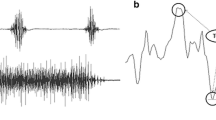Abstract
Objectives: to assess the influence of the skin and muscle temperatures on the turns per second (T/s) and the amplitude per turn (A/T) and to find out whether turn /amplitude analysis requires temperature monitoring. Subjects: ten healthy individuals (three women, seven men) aged 23 to 36 years. Method: recording of two electromyograms (EMGs) in the right biceps brachii muscle from ten locations each, during isometric contractions with 30% of the elbow flexors′ maximum force. The first EMG was recorded after warming the muscle to at least 37° C and the second EMG after cooling the muscle to at least 27° C. Results: lowering the muscle temperature by an average of 10.9° C, the mean T/s decreased from 484 to 436 (P =0.002), the mean A/T increased from 476 to 513 (P =NS) and the mean ratio T/s:A/T decreased from 1.1 to 0.91 (P = 0.0001). None of the individual results became patholgical after cooling the muscle. Conclusion: in a range of 27 to 37° C, turn/amplitude analysis can be performed without temperature monitoring.
Similar content being viewed by others
References[950-953]
Denys EH (1991) AAEE minimonograph 14: the influence of temperature in clinical neurophysiology. Muscle Nerve 14: 795–811
Finsterer J, Mamoli B (1994) T/A-analysis with or without measuring force: problems in the evaluation of normal limits. Electromyogr Clin Neurophysiol 34:215–224
Finsterer J, Mamoli B (1993) Turn/amplitude-analysis and standardized muscular fatigue in neuromuscular disorders. Muscle Nerve 16:801–802
Fuglsang-Frederiksen A, Scheel U, Buchthal F (1977) Diagnostic yield of the analysis of the pattern of electrical activity of muscle and of individual motor unit potentials in neurogenic involvement. J Neurol Neurosurg Psychiatry 40:544–554
Hopf HC, Maurer K (1990) Temperature dependence of the electrical and mechanical responses of the adductor pollicis muscle in humans. Muscle Nerve 13:259–262
Merletti R, Sabbahi MA, DeLuca CJ (1984) Median frequency of the myoelectric signal. Effects of muscle ischemia and cooling. Eur J Appl Physiol 52:258–265
Notermans N, Franssen H, Wieneke G, Wokke J (1994) Temperature dependence of nerve conduction and EMG in neuropathy associated with gammopathy. Muscle Nerve 17:516–522
Winkel J, Jorgensen K (1991) Significance of skin temperature changes in surface electromyography. Eur J Appl Physiol 63:345–348
Author information
Authors and Affiliations
Rights and permissions
About this article
Cite this article
Finsterer, J., Mamoli, B. Temperature dependency of turn/amplitude parameters. Pflügers Arch. 431, 950–953 (1996). https://doi.org/10.1007/s004240050090
Received:
Revised:
Accepted:
Issue Date:
DOI: https://doi.org/10.1007/s004240050090




